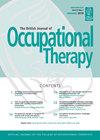手握强度评估的方法和原因
IF 0.9
4区 医学
Q3 REHABILITATION
引用次数: 0
摘要
职业治疗师和物理治疗师会对手部握力(HGS)进行常规评估,以评价手部功能。本研究探讨了定期评估 HGS 的临床医生的经验,包括使用的测试协议、评估方法以及各种生物和功能因素的影响。这项探索性调查(n = 49)通过网络分发给澳大利亚手部治疗协会的会员。问卷要求受访者确定 HGS 测试方案、评估方法、常模数据的使用、评估原因以及生物和功能因素对 HGS 的影响。同时还收集了人口统计学数据。64%的受访者是职业治疗师,59%的受访者拥有 10 年以上的 HGS 评估经验。只有 67% 的受访者始终采用美国手部治疗师协会 (ASHT) 的标准化测试方案。在收缩时间、评分和评估方法方面存在差异。性别、年龄、就业和生活方式被认为是影响 HGS 的功能和生物因素。本研究详细介绍了澳大利亚职业治疗师和物理治疗师评估 HGS 的方法和原因。ASHT 测试协议的使用并不普遍。临床医生根据评估原因、临床经验和实践背景来决定如何评估 HGS。本文章由计算机程序翻译,如有差异,请以英文原文为准。
The how and why of handgrip strength assessment
Occupational therapists and physiotherapists routinely assess Hand grip Strength (HGS) to evaluate hand function. This study explored the experiences of clinicians who regularly assess and evaluate HGS including the testing protocol utilised, evaluation methods and the influence of various biological and functional factors. This exploratory survey ( n = 49) was distributed online to members of the Australian Hand Therapy Association. The questionnaire asked recipients to identify HGS testing protocols, evaluation methods, use of normative data, reasons for assessment and the influence of biological and functional factors on HGS. Demographic data was also collected. Sixty-four percent of respondents were occupational therapists and 59% had over 10 years’ experience assessing HGS. The standardised American Society of Hand Therapists (ASHT) testing protocol was consistently adopted by only 67% of respondents . Variations in contraction time, scoring and evaluation methods were identified. Gender, age, employment and lifestyle were considered the functional and biological factors which influence HGS. This study details how and why occupational therapists and physiotherapists in Australia assess and evaluate HGS. Use of the ASHT testing protocol is not universal. Clinicians rely on the reason for assessment, clinical experience and practice context to determine how they assess and evaluate HGS.
求助全文
通过发布文献求助,成功后即可免费获取论文全文。
去求助
来源期刊

British Journal of Occupational Therapy
REHABILITATION-
CiteScore
2.20
自引率
15.40%
发文量
81
审稿时长
6-12 weeks
期刊介绍:
British Journal of Occupational Therapy (BJOT) is the official journal of the Royal College of Occupational Therapists. Its purpose is to publish articles with international relevance that advance knowledge in research, practice, education, and management in occupational therapy. It is a monthly peer reviewed publication that disseminates evidence on the effectiveness, benefit, and value of occupational therapy so that occupational therapists, service users, and key stakeholders can make informed decisions. BJOT publishes research articles, reviews, practice analyses, opinion pieces, editorials, letters to the editor and book reviews. It also regularly publishes special issues on topics relevant to occupational therapy.
 求助内容:
求助内容: 应助结果提醒方式:
应助结果提醒方式:


